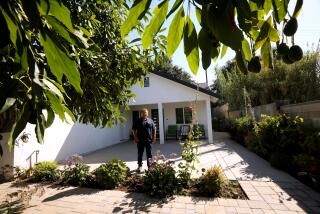State’s Home Builders Shift Into High Gear
Residential construction activity in California surged beyond expectations in the first quarter, resulting in sporadic labor and supply shortages and prompting the state’s home building industry to boost its forecast for the year.
The California Building Industry Assn. says it now expects the state to add 176,800 new houses and apartments this year. Builders were already on track to construct the largest number of homes since 1989, but the trade group tacked on an additional 6,000 units to its forecast after seeing the big jump in activity during the first three months of the year.
In the quarter, builders statewide obtained 47,187 residential permits, up 34% from a year earlier, according to the Burbank-based Construction Industry Research Board. The biggest increases came in apartments, and in Southern California housing overall. Permits are normally issued shortly before construction and are considered a good indicator of building activity.
“The low interest rates are helping us out tremendously,” said Robert Rivinius, chief executive of the state builders group. “If rates stay at a reasonable level ... we will have another good year.”
Although there are signs of a slowdown in housing sales and rising apartment vacancies in parts of the state, most builders are pressing ahead and in some cases increasing production. Even with the projected increase in building this year, the supply of housing may not keep up with the state’s population growth.
Los Angeles-based KB Home Corp. said it might build 10% more homes than first planned in the Los Angeles area because of strong demand this year, said Jay Moss, who heads the company’s Southland division. At the company’s Sierra Lakes development in Fontana, for example, about 10 homes a week are being sold at prices exceeding $300,000, he said.
The war in Iraq “didn’t put any damper on the buying public,” Moss said.
First-quarter statistics show the Inland Empire leading the state, with Riverside and San Bernardino counties issuing 10,789 building permits -- a 54% increase over last year. The San Diego region came in second with 5,746 permits, up 45%, and the Los Angeles-Long Beach area was next with 5,084 permits, a gain of 51%.
Developer Randall Lewis said his company is planning to build as many as 1,000 dwellings across the state, including large apartment communities in the Inland Empire and Sacramento. In the Riverside County town of Mira Loma, he said, more than 90 prospective tenants put down deposits weeks before the first phase of Lewis’ Homecoming development, where monthly rents will start at $1,200.
“We are making a big commitment to the apartment business in California because rising house prices encourage more people to rent,” Lewis said.
As the pace of home building has picked up, so has the demand for construction workers across California -- even as employment in most other industries has dropped or remained flat.
During March, the state’s residential construction sector employed more than 113,000 people, up 5.5% from a year earlier, according to the state’s Employment Development Department.
Builders say that for the most part that they have been able to hire as many workers and obtain as much material as needed to complete their projects. But with the industry working at full steam, some are struggling to stay on schedule.
At the giant Playa Vista project near Marina del Rey, where nearly 2,000 apartments and homes are under construction, a shortage of scaffolding triggered some minor delays, said Bob Turbin, vice president of residential land development at Playa Vista.
“Everybody needs it all at the same time,” said Turbin, who estimates that as many as 700 construction workers a day converge on the site.
In the Central Coast community of Morro Bay, home builder Wayne Colmer is on the verge of starting work on 30 homes but said he and his subcontractors face a shortage of skilled labor. His solution: Import workers who live more than 100 miles away in Ventura County.
“There is a limited labor supply and they are working at full capacity,” Colmer said.
More to Read
Inside the business of entertainment
The Wide Shot brings you news, analysis and insights on everything from streaming wars to production — and what it all means for the future.
You may occasionally receive promotional content from the Los Angeles Times.










